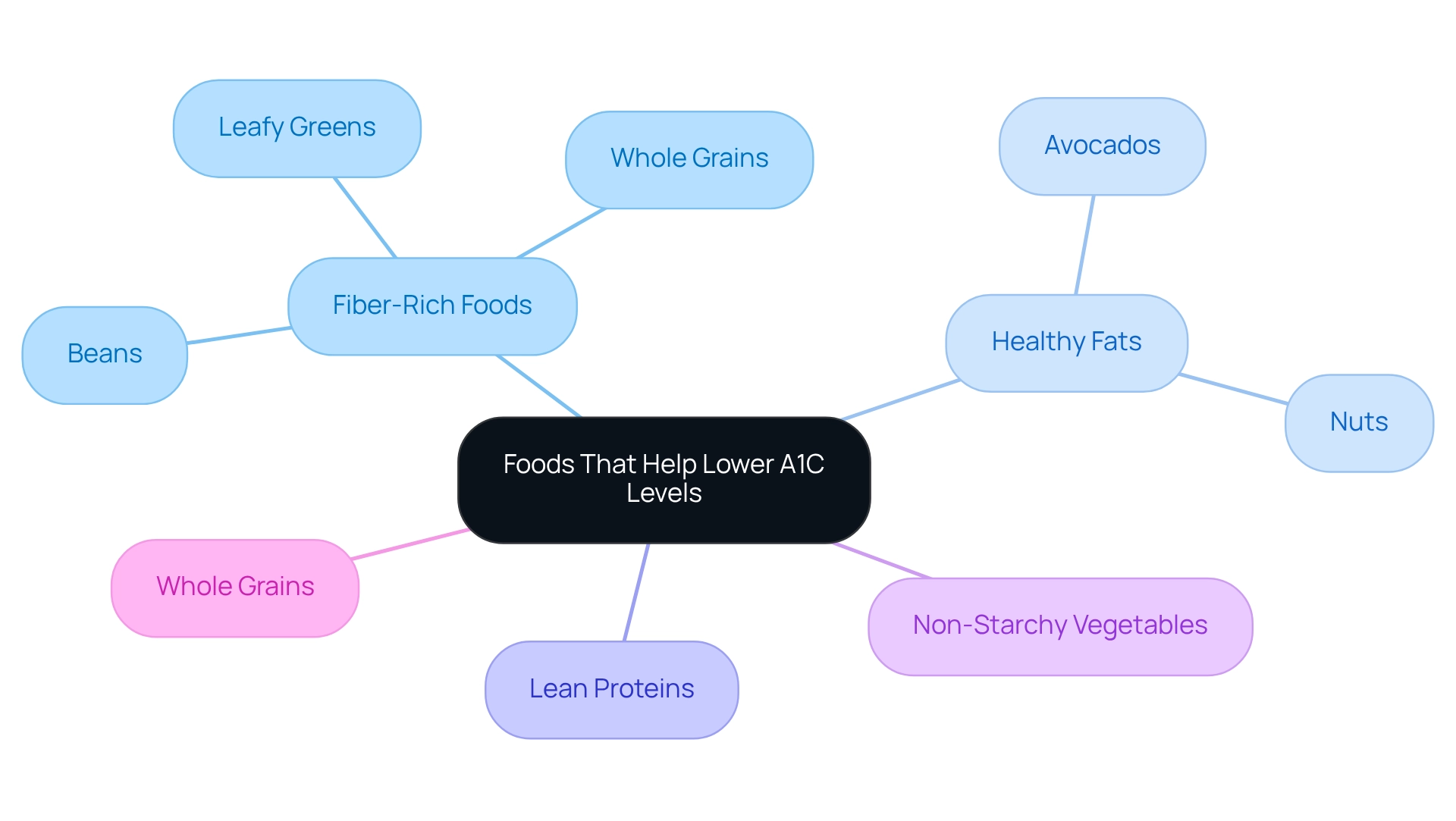Overview
Are you feeling overwhelmed by your journey to manage your A1C levels? You’re not alone, and there are natural ways to help you feel more in control. Simple dietary changes, regular exercise, effective stress management, and improving sleep quality can make a significant difference in your health.
Research shows that adopting a multifaceted approach—combining these lifestyle adjustments—can lead to more substantial reductions in A1C levels. Individuals who embrace a holistic strategy often experience better blood sugar control and overall health outcomes.
Together, we can achieve your goals. By focusing on these key areas, you can take meaningful steps toward improving your well-being. Remember, every small change counts, and we’re here for you every step of the way.
Introduction
In your journey toward optimal health, understanding A1C levels stands as a vital cornerstone in managing diabetes and preventing its complications. A1C, a crucial blood test that reflects your average blood sugar over the past few months, not only helps in diagnosing diabetes but also acts as an important indicator of how well you are managing your blood sugar.
As diabetes becomes more prevalent, particularly among younger individuals, the financial and health challenges associated with high A1C levels grow increasingly urgent. This article explores the significance of A1C testing and offers:
- Dietary strategies
- Insights on exercise
- Stress management techniques
- The importance of quality sleep
All essential components for achieving and maintaining healthy A1C levels. By embracing a comprehensive approach, you can empower yourself to make informed decisions that enhance your overall well-being and navigate your health journey with confidence. Together, we can achieve your goals.
Understanding A1C: What It Is and Why It Matters
A1C, or hemoglobin A1C, is a vital test that reflects average glucose concentrations over the past two to three months. This measurement is crucial for diagnosing diabetes and assessing the effectiveness of blood sugar management strategies. Normal A1C values are defined as below 5.7%.
When levels range from 5.7% to 6.4%, they indicate prediabetes, while an A1C of 6.5% or higher confirms a diabetes diagnosis.
As we look ahead to 2025, the average A1C readings in the United States highlight a growing concern, with many individuals struggling to maintain ideal figures. Recent studies reveal that the medical costs associated with diabetes have surged from $10,179 to $12,022 per person between 2012 and 2022. This financial burden underscores the urgent need for effective management strategies.
Experts in endocrinology emphasize that A1C testing is not just a diagnostic tool; it is a crucial element of ongoing diabetes management. As Dr. Chance Miller remarked, “Comprehending A1C values is essential for customizing treatment strategies and lifestyle changes that can greatly influence sugar management.”
This personalized approach is vital, especially since high A1C readings may indicate diabetes or an increased risk of complications, necessitating important adjustments in treatment by healthcare providers.
At Minimal, we recognize that A1C readings are directly tied to blood sugar control. Elevated A1C levels suggest inadequate management, which can lead to serious complications. Our comprehensive weight loss prescription program combines personalized treatments, fitness training, and nutrition guidance to help individuals achieve optimal wellness results. We also provide services like Continuous Glucose Monitoring and Acupuncture to further support our clients.
Target A1C values vary based on personal factors such as age and overall health, with guidelines generally recommending figures below 6.5% for younger individuals and between 7.0% and 8.5% for older adults.
Real-world examples demonstrate the effectiveness of A1C testing in diabetes management. Many patients have successfully reduced their A1C levels through lifestyle changes, like diet and exercise, which are natural ways to lower A1C, highlighting the test’s significance in guiding treatment adjustments. Case studies, such as Minimal’s commitment to transformative care, show that individuals who actively track their A1C levels and embrace holistic wellness practices often achieve improved health outcomes.
The personalized support from a dedicated care team, including physicians, plays a crucial role in this success.
In conclusion, A1C is more than just a number; it is a critical measure of diabetes management and overall well-being. Understanding its implications empowers individuals to make informed choices about their health and wellness journey, especially when supported by Minimal’s holistic approach to personalized weight loss solutions and comprehensive care. We invite you to explore our services and consult with our professionals for tailored support in managing your health.
Dietary Approaches: Foods That Help Lower A1C Levels
Incorporating specific foods into your diet can be a natural and effective way to lower A1C readings. Have you considered the benefits of foods rich in fiber? Whole grains, legumes, and a variety of vegetables are particularly advantageous as they slow glucose absorption, leading to more stable sugar concentrations. Additionally, including healthy fats from sources like avocados and nuts can enhance insulin sensitivity, further supporting your journey in managing blood sugar levels.
Recent studies underscore the effectiveness of a diet rich in non-starchy vegetables, lean proteins, and whole grains as a means to lower A1C values naturally. For instance, imagine filling half your plate with vibrant non-starchy vegetables and choosing whole grains over refined carbohydrates. This simple shift can lead to significant improvements in blood sugar control.
Nutritionists often emphasize that even small dietary changes can yield substantial benefits over time. As Tara Seymour, an advanced practice clinical dietitian and diabetes educator, wisely notes, “Life doesn’t always give you the time to change the outcome. Prediabetes does.” This serves as a reminder of the crucial role diet plays in a broader strategy for managing conditions like prediabetes.
Moreover, research indicates that individuals who engage in Diabetes Self-Management Education (DSME) report greater abilities and confidence in managing their diabetes. This highlights the importance of making informed dietary choices together.
Looking ahead to 2025, the focus on foods that can help reduce A1C values continues to evolve, especially with an emphasis on fiber-rich choices. Studies show that increasing fiber intake is one of the most natural ways to lower A1C values, making it an essential part of your dietary management. Real-life examples of effective foods include leafy greens, beans, and whole oats, all of which contribute positively to blood sugar regulation.
Additionally, the duration of following a ketogenic diet can vary, ranging from a minimum of 2 to 3 weeks to as long as 6 to 12 months, providing flexible options for dietary approaches. By making informed dietary choices, you can discover effective natural ways to lower A1C values. It’s also important to consider the need for improved approaches to address financial burdens and environmental factors in diabetes self-management, as these challenges can significantly impact your ability to maintain a healthy lifestyle. Remember, we’re here for you, and together, we can achieve your goals.
The Role of Exercise: How Physical Activity Affects A1C
Participating in consistent physical activity is recognized as one of the most effective natural ways to lower A1C values. Exercise significantly enhances insulin sensitivity, enabling the body to utilize glucose more efficiently. Have you considered how simple activities like walking, cycling, or swimming can make a difference? Research shows that both aerobic exercises and resistance training contribute to notable reductions in A1C levels.
For instance, individuals who engage in at least 150 minutes of moderate-intensity exercise weekly can experience a decrease in A1C by approximately 0.5% to 1%. Imagine the positive impact this could have on your health journey!
Incorporating a balanced routine that includes both aerobic and strength training not only supports weight management but also promotes enhanced metabolic function. Clients at Minimal have seen remarkable results, with some losing up to 20% of their weight based on data from over 70,000 patients who have participated for at least six months. This highlights the effectiveness of exercise in weight management and A1C reduction. Recent studies have demonstrated that consistent physical activity can lead to sustained improvements in blood sugar control, with many participants continuing their exercise regimens long after initial interventions.
Dr. Chance Miller emphasizes, “Clients appreciate the personalized attention from a dedicated care team, which includes physicians like myself, who emphasize transformative care.” Real-world instances show how individuals have effectively incorporated natural ways to lower A1C through committed exercise routines, underscoring the significant influence of physical activity on overall well-being.
To maximize A1C reduction, a combination of different types of physical activity is recommended. Aerobic exercises are particularly effective for immediate glucose control, while resistance training builds muscle mass, enhancing metabolic rate and further improving insulin sensitivity. This diverse method of exercise is crucial for anyone seeking natural ways to lower A1C values effectively.
Furthermore, Minimal provides customized weight loss strategies that incorporate personalized fitness and nutrition plans, ensuring clients receive extensive assistance in their wellness journey. With access to efficient wellness solutions beginning at just $49 for the initial month, Minimal makes it budget-friendly and convenient for clients to engage in physical activity and effectively control their A1C values. The strengthened relationships between the research team and patients over eight years further highlight the importance of sustained physical activity in maintaining health. Together, we can achieve your goals for a healthier future.
Managing Stress: Techniques to Support Healthy A1C Levels
Persistent stress can significantly impact glucose concentrations, primarily through the release of stress hormones like cortisol, leading to increased A1C readings. If you find yourself struggling with this, know that methods such as mindfulness, meditation, and yoga have emerged as effective natural ways to lower A1C while alleviating stress. Research shows that individuals who regularly practice stress management techniques often experience improved glycemic control.
For example, studies have indicated that mindfulness meditation is linked to reduced A1C values, highlighting its promise as a beneficial approach for those managing diabetes. Have you considered how simple practices could make a difference in your health?
In addition to mindfulness, engaging in hobbies, socializing, and participating in physical activities can further ease stress and contribute to overall well-being. A significant case study involving expectant mothers with gestational diabetes evaluated the effectiveness of Mindfulness-Based Stress Reduction (MBSR) on perceived stress and glucose concentrations. This study utilized a cluster sampling technique across six medical centers, with participants randomly assigned to either an intervention group receiving MBSR sessions or a control group receiving standard care.
The findings revealed that the intervention group experienced a notable decrease in perceived stress and fasting blood sugar (FBS) levels compared to the control group. This emphasizes how structured stress management programs can enhance glycemic control. Together, we can explore these supportive techniques to improve your health.
Psychologists advocate for incorporating stress management techniques into diabetes care, underscoring their role in enhancing coping mechanisms and overall health. As Beatriz Ruiz-Ariza noted, “The evidence backs the use of mind-body training to lower stress, depression, and anxiety in the adult population with T2DM, making this training a significant intervention within a comprehensive strategy for diabetic pathology.” As we move through 2025, incorporating mindfulness and meditation into daily routines is increasingly recognized as a natural way to lower A1C. This approach offers a straightforward, budget-friendly method for managing stress and enhancing blood sugar, especially for individuals who may find more intense physical activities challenging.
By prioritizing these techniques, you can take proactive steps toward discovering natural ways to lower A1C measurements and achieve better health outcomes. Remember, we’re here for you on this journey.
Sleep and A1C: The Connection Between Rest and Blood Sugar Control
Quality sleep is one of the natural ways to lower A1C values and maintain overall health. Have you ever considered how inadequate sleep might be affecting your glucose metabolism? It can increase insulin resistance, leading to higher sugar concentrations. Research shows that individuals who average less than seven hours of sleep per night face a significantly increased risk of developing type 2 diabetes.
Creating a regular sleep routine, fostering a calming atmosphere, and following proper sleep hygiene practices are essential steps in lowering A1C readings by improving sleep quality. For instance, aiming for 7-9 hours of rest each night can help regulate hormones that control appetite and glucose metabolism, ultimately aiding in better sugar management.
Recent studies have highlighted the alarming trend of rising type 2 diabetes rates among U.S. children and adolescents, particularly affecting diverse racial and ethnic groups. This underscores the importance of addressing lifestyle factors, including sleep, in diabetes prevention strategies. Moreover, lack of sleep has been associated with impaired sugar regulation, emphasizing the need for natural ways to lower A1C readings, as insufficient rest can lead to elevated levels over time.
Significantly, clients of Minimal can lose up to 20% of their weight, according to data from over 70,000 patients who have participated for at least six months. This highlights the importance of lifestyle changes, including natural ways to lower A1C, such as improving sleep quality, in managing A1C values.
Insights from sleep specialists strengthen the link between sleep and blood sugar, suggesting that inadequate sleep quality can worsen diabetes risk. For example, a case study involving individuals who enhanced their sleep patterns showed a significant decrease in A1C values, emphasizing the potential advantages of prioritizing sleep. Dr. Lorena Alarcon-Casas Wright, a physician at the University of Washington Diabetes Institute, states, “I trust it will soon be standard of care for patients on intensive insulin regimens and a game changer with the advent of the artificial pancreas.”
By understanding and addressing the connection between sleep quality and A1C numbers, individuals can adopt natural ways to lower A1C and take proactive measures toward improved health outcomes. Additionally, it’s important to recognize that average medical expenditures for people with diagnosed diabetes are 2.6 times higher than they would be in the absence of diabetes. This highlights the economic impact of diabetes and the importance of preventive measures, including enhancing sleep quality. Minimal’s comprehensive strategy for customized weight loss solutions can further assist individuals in achieving better sleep and discovering effective natural ways to lower A1C values.
Comparative Analysis: Evaluating the Effectiveness of Lifestyle Changes on A1C
A multifaceted approach to lifestyle changes is truly the most effective strategy for reducing A1C values. At Minimal, we embody this philosophy by offering natural ways to lower A1C through our holistic wellness solutions. Have you considered how dietary changes can lead to prompt enhancements in sugar regulation? Exploring natural ways to lower A1C through our customized fitness training can promote long-term metabolic well-being. Moreover, managing stress and ensuring adequate sleep are vital components in stabilizing blood sugar levels and enhancing your overall well-being.
At Minimal, we combine weight loss prescriptions, such as Semaglutide, with personalized fitness and nutrition advice. We also offer alternative therapies like breathwork and acupuncture to support your journey toward lasting well-being improvements.
Research shows that individuals who adopt a mix of these strategies achieve greater reductions in A1C compared to those who focus solely on one element. For instance, participants who integrated dietary changes with consistent exercise experienced an average A1C reduction of 1.5%. In contrast, those relying on dietary adjustments alone saw only a 0.5% decrease. Additionally, the TODAY Study found that metformin therapy managed glycemia in half of the participants with youth-onset T2D, underscoring the potential of medication when combined with lifestyle changes.
The clinical implementation of lifestyle diabetes prevention strategies has proven to be both feasible and effective. It promotes dietary and physical activity counseling for high-risk patients, ensuring they receive the support they need.
Dr. Chance Miller emphasizes that clients truly value the personalized attention from our committed care team at Minimal. This dedicated support is essential for achieving transformative wellness outcomes. This evidence highlights the importance of a comprehensive approach to diabetes management, where implementing natural ways to lower A1C through various lifestyle interventions can lead to optimal wellness outcomes.
It’s also noteworthy that the weight loss benefit of pramlintide is often overshadowed by GLP-1 receptor agonists. Furthermore, the durability of glycemic control with TZDs is more prolonged than with sulfonylureas or metformin, providing a broader understanding of medication effectiveness over time. Together, we can explore additional ways Minimal can assist you on your path to reducing A1C values and attaining lasting health enhancements. Reach out to us today; we’re here for you.
Practical Tips: Implementing Natural Strategies to Lower A1C
To effectively reduce A1C readings naturally, consider implementing the following practical strategies:
- Increase Fiber Intake: Aim for at least 25-30 grams of fiber daily by incorporating a variety of fruits, vegetables, and whole grains into your meals. Fiber aids in controlling sugar concentrations and can enhance overall digestive wellness.
- Engage in Regular Physical Activity: Set a goal of at least 150 minutes of moderate exercise each week. Activities like brisk walking, cycling, or swimming can improve insulin sensitivity and assist in sugar control.
- Practice Stress Management Techniques: Incorporate mindfulness practices, yoga, or deep breathing exercises into your daily routine. Decreasing stress can reduce cortisol amounts, which is advantageous for sustaining balanced blood sugar concentrations.
- Prioritize Sleep: Establish a consistent sleep schedule and create a restful environment to improve sleep quality. Sufficient sleep is essential for metabolic well-being and can positively impact A1C levels.
- Monitor Your A1C Readings Regularly: Keep track of your A1C readings to evaluate your progress and make necessary adjustments to your lifestyle strategies. Regular monitoring can enable you to remain focused on your wellness objectives. Recent research emphasizes the creative aspect of home monitoring of A1C and the significance of consistent communication between patients and healthcare providers in managing diabetes effectively.
The increasing occurrence of type 2 diabetes, with 5,293 children and adolescents aged 10 to 19 diagnosed during 2017-2018, highlights the necessity of controlling A1C values, especially in younger populations. As A Enrique Caballero from Brigham and Women’s Hospital observes, early intervention and education are essential to prevent long-term complications related to diabetes. By adopting these strategies, individuals can proactively manage their A1C levels and discover natural ways to lower A1C, which will improve their overall well-being.
Real-world examples show that those who integrate these lifestyle changes often experience significant improvements in their blood sugar control, reinforcing the importance of a holistic approach to health management. Together, we can achieve your goals and support your journey to better health.
Conclusion
Understanding and managing A1C levels is crucial for anyone navigating the complexities of diabetes. This article has explored various strategies essential for achieving and maintaining healthy A1C levels, including:
- Dietary changes
- Regular physical activity
- Effective stress management
- Prioritizing quality sleep
Each of these components plays a significant role in not only lowering A1C levels but also enhancing overall well-being.
By incorporating fiber-rich foods, engaging in consistent exercise, practicing mindfulness, and ensuring adequate rest, individuals can take proactive steps toward better blood sugar control. The evidence presented demonstrates that a holistic approach—one that combines these lifestyle modifications—yields the most significant improvements in A1C levels. Furthermore, the importance of regular monitoring and personalized support cannot be overstated; these elements empower individuals to make informed decisions about their health journey.
As diabetes continues to pose increasing health challenges, especially among younger populations, adopting these strategies becomes more critical than ever. By embracing a comprehensive and proactive approach to health management, individuals can navigate the complexities of diabetes with confidence. This ultimately leads to healthier lives and reduced risks of complications. Emphasizing the connection between lifestyle choices and A1C levels provides a pathway toward sustainable health improvements and a better quality of life. Remember, together, we can achieve your goals and build a healthier future.
Frequently Asked Questions
What is A1C and why is it important?
A1C, or hemoglobin A1C, is a test that reflects average glucose concentrations over the past two to three months. It is crucial for diagnosing diabetes and assessing blood sugar management strategies.
What are the normal and abnormal A1C levels?
Normal A1C values are below 5.7%. Levels from 5.7% to 6.4% indicate prediabetes, while an A1C of 6.5% or higher confirms a diabetes diagnosis.
How have diabetes-related medical costs changed recently?
Between 2012 and 2022, the medical costs associated with diabetes increased from $10,179 to $12,022 per person, highlighting the urgent need for effective management strategies.
How does A1C testing contribute to diabetes management?
A1C testing is not only a diagnostic tool but also essential for ongoing diabetes management, helping customize treatment strategies and lifestyle changes to influence blood sugar management.
What role does personalized support play in managing A1C levels?
Personalized support from a dedicated care team, including physicians, is crucial for success in managing A1C levels and achieving improved health outcomes.
What dietary changes can help lower A1C readings?
Incorporating foods rich in fiber, such as whole grains, legumes, and non-starchy vegetables, can naturally help lower A1C readings. Healthy fats from sources like avocados and nuts can also enhance insulin sensitivity.
How effective are small dietary changes in managing A1C levels?
Even small dietary changes can yield substantial benefits over time, contributing positively to blood sugar control.
What is the significance of Diabetes Self-Management Education (DSME)?
DSME helps individuals gain greater abilities and confidence in managing their diabetes, emphasizing the importance of informed dietary choices.
What types of foods are recommended for lowering A1C values?
Foods such as leafy greens, beans, whole oats, and a diet rich in non-starchy vegetables, lean proteins, and whole grains are effective in lowering A1C values.
How long can one follow a ketogenic diet for A1C management?
The duration for following a ketogenic diet can vary, ranging from a minimum of 2 to 3 weeks to as long as 6 to 12 months, providing flexible options for dietary approaches.




















